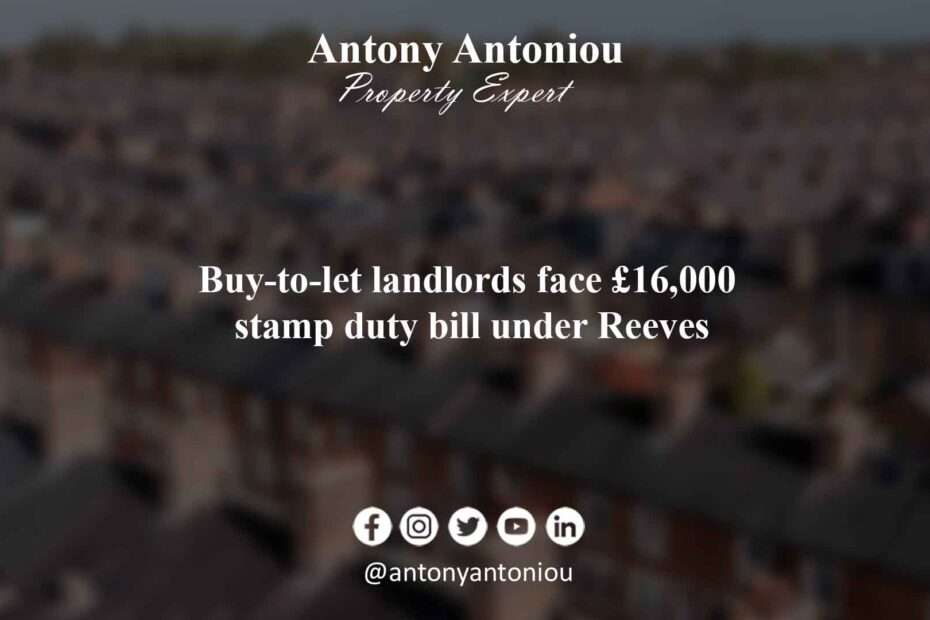Buy-to-let landlords face £16,000 stamp duty bill under Reeves
The steep rise is expected to drive up rents as landlords pass on additional costs to tenants
Buy-to-let landlords are bracing for stamp duty bills as high as £16,190 following Rachel Reeves’s Budget tax reforms, according to recent research.
The increased financial burden on property investors has surfaced after the Chancellor confirmed her plans to reverse tax breaks introduced by the Conservatives in 2022. The stamp duty surcharge on second homes will rise from 3% to 5%.
Based on the average price of a buy-to-let property across Britain, stamp duty bills are set to nearly double, climbing from £8,452 to £16,190 by April 2025. This projection comes from research by JLL, which utilised data from the Office for National Statistics (ONS), Zoopla, and Rightmove.
The sharp increase is expected to push up rental costs as landlords look to recover their outlays.
According to JLL, the higher stamp duty will equate to roughly 11 months’ worth of rental income under the current system, compared to seven months before the Chancellor’s October Budget. From April 2025, this figure is forecast to rise further, amounting to the equivalent of 13 months’ rent.
Stamp duty, paid by the buyer on property purchases in England and Northern Ireland, has long been one of the country’s most controversial taxes, drawing criticism from both consumers and economists.
Following Ms Reeves’s announcement to raise stamp duty during her first Budget, Paul Johnson, head of the Institute for Fiscal Studies, criticised the move, warning it would “make housing even more immobile and drive up rents even further.” He described stamp duty as “the most damaging tax we have.”
The looming rise in stamp duty has already prompted an increase in the number of landlords exiting the market. Data from Rightmove shows a 6% increase in new property listings from landlords looking to sell in November.
However, the implications extend beyond existing landlords leaving the market. JLL cautions that higher taxes are likely to deter new investors from entering the buy-to-let sector.
Marcus Dixon, Head of UK Living and Residential Research at JLL, explained: “The costs for buy-to-let investors to enter the market have risen sharply following the Budget. While exit costs, such as capital gains tax, remain unchanged, the combination of rising entry costs and static exit costs means we are likely to see a continued decline in new entrants and an increase in landlords leaving the market.”
This trend could exacerbate an already challenging rental market. As landlords exit and fewer new investors step in, the supply of rental properties may dwindle, adding further pressure to tenants facing higher rents.
The Chancellor’s decision to increase taxes on second homeowners and buy-to-let investors is part of broader efforts to address economic challenges. However, critics argue that the measures could have unintended consequences, including reduced housing availability and affordability in the private rental sector.
With April 2025 fast approaching, landlords are faced with tough decisions about whether to stay in the market or sell up. Meanwhile, tenants are likely to bear the brunt of rising costs as landlords adjust their strategies to accommodate the higher tax burden.
This development marks yet another challenge for the UK housing market, which continues to grapple with affordability, rising interest rates, and ongoing regulatory changes. As the government seeks to balance tax revenue with housing policy, the debate over stamp duty’s effectiveness and fairness is sure to persist.
Summary Conclusion
- Increased Stamp Duty Costs: Buy-to-let landlords will face nearly double the stamp duty surcharge, rising from 3% to 5%, with average bills increasing to £16,190 by April 2025.
- Impact on Rental Market: The higher costs are expected to push up rents, as landlords pass on the financial burden to tenants.
- Strain on Landlords: The inflated stamp duty is equivalent to 11 months of rental income currently, set to rise to 13 months by 2025, adding pressure on property investors.
- Landlord Exodus: Rising costs have prompted more landlords to exit the market, with a 6% rise in new property listings from landlords looking to sell.
- Barrier to Entry: Higher entry costs are likely to deter new buy-to-let investors, further reducing the supply of rental properties.
- Tenant Challenges: A reduced rental market and rising rents will place further strain on tenants, exacerbating the affordability crisis.
- Policy Criticism: Economists and critics, including the Institute for Fiscal Studies, argue that the move will make housing less mobile, reduce supply, and drive up rents.
- Long-term Uncertainty: The changes risk creating a less accessible housing market, both for tenants and prospective landlords, while debates about the fairness and efficiency of stamp duty continue.

